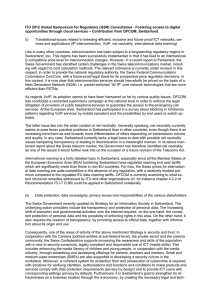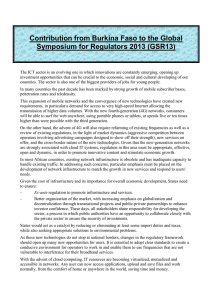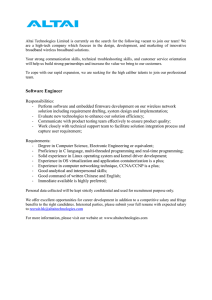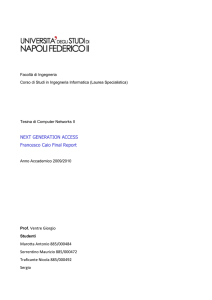2011 Global Symposium for Regulators
advertisement
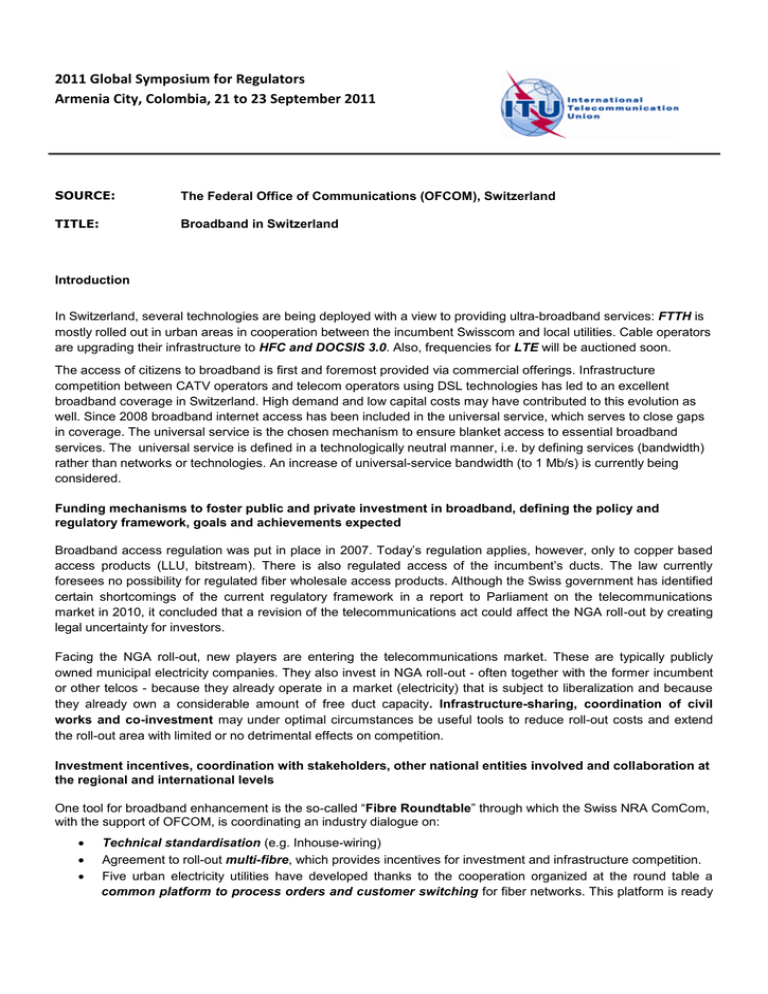
2011 Global Symposium for Regulators Armenia City, Colombia, 21 to 23 September 2011 SOURCE: The Federal Office of Communications (OFCOM), Switzerland TITLE: Broadband in Switzerland Introduction In Switzerland, several technologies are being deployed with a view to providing ultra-broadband services: FTTH is mostly rolled out in urban areas in cooperation between the incumbent Swisscom and local utilities. Cable operators are upgrading their infrastructure to HFC and DOCSIS 3.0. Also, frequencies for LTE will be auctioned soon. The access of citizens to broadband is first and foremost provided via commercial offerings. Infrastructure competition between CATV operators and telecom operators using DSL technologies has led to an excellent broadband coverage in Switzerland. High demand and low capital costs may have contributed to this evolution as well. Since 2008 broadband internet access has been included in the universal service, which serves to close gaps in coverage. The universal service is the chosen mechanism to ensure blanket access to essential broadband services. The universal service is defined in a technologically neutral manner, i.e. by defining services (bandwidth) rather than networks or technologies. An increase of universal-service bandwidth (to 1 Mb/s) is currently being considered. Funding mechanisms to foster public and private investment in broadband, defining the policy and regulatory framework, goals and achievements expected Broadband access regulation was put in place in 2007. Today’s regulation applies, however, only to copper based access products (LLU, bitstream). There is also regulated access of the incumbent’s ducts. The law currently foresees no possibility for regulated fiber wholesale access products. Although the Swiss government has identified certain shortcomings of the current regulatory framework in a report to Parliament on the telecommunications market in 2010, it concluded that a revision of the telecommunications act could affect the NGA roll-out by creating legal uncertainty for investors. Facing the NGA roll-out, new players are entering the telecommunications market. These are typically publicly owned municipal electricity companies. They also invest in NGA roll-out - often together with the former incumbent or other telcos - because they already operate in a market (electricity) that is subject to liberalization and because they already own a considerable amount of free duct capacity. Infrastructure-sharing, coordination of civil works and co-investment may under optimal circumstances be useful tools to reduce roll-out costs and extend the roll-out area with limited or no detrimental effects on competition. Investment incentives, coordination with stakeholders, other national entities involved and collaboration at the regional and international levels One tool for broadband enhancement is the so-called “Fibre Roundtable” through which the Swiss NRA ComCom, with the support of OFCOM, is coordinating an industry dialogue on: Technical standardisation (e.g. Inhouse-wiring) Agreement to roll-out multi-fibre, which provides incentives for investment and infrastructure competition. Five urban electricity utilities have developed thanks to the cooperation organized at the round table a common platform to process orders and customer switching for fiber networks. This platform is ready Page 2 for trial operation and will enable an easy access for national service providers on the regional utilities’networks. Agreement on economically efficient roll-out by using empty ducts of the utilities and avoiding parallel networks via coordination. Agreement that home owners should be consulted. For reaching a fast NGA roll-out and a sufficient number of subscriptions, inhouse-wiring is, for the time being, generally paid by the operators based on a contract with each home owner. The competition authority has decided to review certain co-operation contracts against possible anti-competitive clauses. In addition to the NRA’s Fibre Round Table, OFCOM has now launched a national next generation access multistakeholder process. To the end, a so-called “Next Generation Access” Group has been convened which is composed representatives of federal and sub-federal authorities, telcos, utility companies as well as associations of cities, municipalities and peripheral regions. The aim of this group is threefold: to produce an NGA infrastructure mapping of Switzerland, to assess demand for NGA services and to identify best practices that facilitate the roll-out of NGA networks also in peripheral areas. Expanding Digital literacy Digital literacy is promoted by the national e-Inclusion network (www.einclusion.ch). The network supports projects oriented towards special target groups (e.g. the elderly) as defined in the national action plan on digital inclusion.
